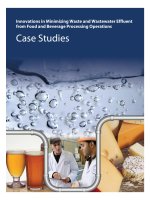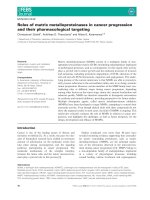Innovations in Minimizing Waste and Wastewater Effluent from Food and Beverage Processing Operations pdf
Bạn đang xem bản rút gọn của tài liệu. Xem và tải ngay bản đầy đủ của tài liệu tại đây (3.94 MB, 68 trang )
Innovations in Minimizing Waste and Wastewater Effluent
from Food and Beverage Processing Operations
Case Studies
Innovations in Minimizing Waste and Wastewater Effluent from
Food and Beverage Processing Operations
Case Studies
Innovations in Minimizing Waste and Wastewater Effluent From Food and Beverage Processing Operations
>> Case Studies 1
Altech Environmental Consulting and OCETA compiled 33 published case studies that describe pollution
prevention and other measures that have been implemented in the food and beverage sector to
minimize waste and wastewater effluent. The case studies were compiled from a variety of sources and
include examples of implemented measures and projects undertaken in Canada, the USA, and
internationally. They cover a number of sub-sectors including dairy, brewing, meat and seafood
processing, dry and baked goods, and other food products.
These case studies can be used as a resource to motivate, inspire and provide guidance to food and
beverage processors in Ontario on identifying and implementing measures to reduce their
environmental footprint and water and waste management costs. The case studies identify specific
opportunities that can be adopted by Ontario food and beverage processors to reduce water use, waste
production, wastewater discharge and energy use, while at the same time increasing their
competitiveness.
The information contained in the case studies was obtained and compiled from publicly available
sources including the Toronto Region Sustainability Program, Water Smart Peel, OCETA, Dalhousie
University, Michigan Department of Environmental Quality, North Carolina Department of Natural
Resources, Water Quality & Waste Management North Carolina , Wisconsin Department of Natural
Resources, Northwest Food Producers Association, Australia Environment, and the University of
Queensland. The information is assumed to be accurate as of the original publishing date.
Summary of Case Studies
Sub-Sector Number of case studies
Dairy 7
Brewing 6
Meat 5
Seafood 3
Snack foods 3
Bakery 3
Baby Food 1
Honey 1
Seaweed 1
Livestock feed 1
Wet Corn Milling 1
Pasta 1
Company Overview
__________________________________________________________________________________________
Bonlac is one of Australia's largest manufacturers of
dairy products, and has grown to become one of the
largest processed food exporters in the country with
markets in more than 50 countries.
The Stanhope facility processes whole milk
transported by road tanker from local suppliers. The
facility produces a variety of cheese, milk powders
and anhydrous milk fat. The manufacturing
processes typically involve demineralisation, cheese
making and spray drying.
Innovations in Minimizing Waste and Wastewater Effluent from
Food and Beverage Processing Operations
Dairy Processing: Bonlac Foods
Highlights
___________________________________________________________________________
• Reduced wash time by 25% and saves
over $300 per day in operating costs by
replacing cleaning chemicals with
Stabilon® detergent
• Reduced effluent by 30% by diverting
wastewater to farm irrigation
• Reduced suspended solids from entering
sewage by installing screens, resulted in
recovery in raw material and increase of
production
Assessment Process
___________________________________________________________________________
The assessment at Bonlac was conducted
under the Cleaner Production Demonstration
Project, an initiative from Environment
Australia – The Environment Protection
Group (EPG). Dames & Moore, assisted by
Energetics, were the technical consultants
on the project, which commenced in June
1994, and ran for 27 months.
Summary of Opportunities
__________________________________________________________________________________________
Bonlac must ensure that all process equipment,
pipes and tanks are kept clean and free of unwanted
micro-organisms. This is achieved with a periodic
chemical flushing process called Cleaning In Place
(CIP). The chemicals used in this process were
discharged into the wastewater treatment facility,
creating an extra load on the system. Replacing the
acid cleaning with a Stabilon® detergent resulted in
greater production capacity and reduced risk of
environmental damage.
Wastewater is diverted to farmland for irrigation of
crops. This is a clean and profitable solution in
dealing with large volumes of effluent and reducing
the burden on the wastewater treatment system.
When producing cheese and milk powder, Bonlac
was faced with the problem of preventing small
particles of cheese entering its wastewater drainage
system. Screens were installed to capture the cheese
solids which normally was lost to the drains. This
resulted in high product recovery rates and
reduction of organic loading into the wastewater
treatment system and the environment.
Program Description
The Alliance of Ontario Food Processors has partnered with
ALTECH Environmental Consulting Ltd., the Ontario Centre
for Environmental Technology Advancement (OCETA), and
the Canadian Centre for Pollution Prevention (C2P2) to
compile information on published case studies to reduce the
environmental footprint of food and beverage processing
operations. Information contained in the case studies was
accurate as of the original publishing date. No effort was
made to update or verify the information.
Contact Information
Jay Mullin, Project Analyst
OCETA
905-822-4133 ext. 238
Prepared by:
With support from:
Process Solutions Environmental Results Cost Savings
Used acidic cleaning
solution during Cleaning-in-
Place (CIP)
Replaced alkaline solution
and acid detergents with
Stabilon® detergent
Reduced nitrate and
phosphate load in
wastewater
Reduced total volume of
effluent from being
disposed to wastewater
treatment facility
Net benefit of $311 per day
from reduced detergent
cleaning water and
electricity consumption;
reduced cleaning time; and
increased production time
Created extra load on
wastewater treatment
facility
Diverted wastewater to farm
irrigation
Installed irrigation system
on Bonlac owned farmland
Reduced the amount of
wastewater to be treated by
facility
Reduced hydraulic loading
of wastewater to local
waterway
Reduced wastewater
treatment costs
Grew millet grass on
irrigated farmlands to be
later sold as fodder for cattle
Cheese solids entered
wastewater draining system
Installed screens to capture
solids
Reduced total suspended
solids (TSS) and organic load
to wastewater treatment
system and local waterway
Increased efficiency in
resource consumption from
recoveries of useable raw
material
Increased production from
raw material recovery
Less than 4 months payback
Source: “Cleaner Production Demonstration Project at Bonlac Foods, Stanhope”, Environment Australia -The Environment Protection
Group (EPG),
Originally published in unknown date.
Company Overview
__________________________________________________________________________________________
Dairy Farmers manufactures milk products including
whole milk, modified milk, flavoured milk, cream and
also milk, cream and cheese powders. The factory
has been situated in Jacaranda St, Booval for over
one hundred years. The factory operates 24 hours
per day, 7 days per week and employs over 200
people.
Innovations in Minimizing Waste and Wastewater Effluent from
Food and Beverage Processing Operations
Dairy Processing: Dairy Farmers
Highlights
___________________________________________________________________________
• Savings of $324,000 per year from
increased product yield
• Annual savings of $62,000 from
reduced COD loading of wastewater
• Annual savings of $73,000 from
reduced water consumption
• Annual savings of $14,400 in reduced
chemical expenses
Assessment Process
___________________________________________________________________________
A milk manufacturing plant has the capacity
to produce a vast amount of waste and the
plant at Booval is no exception. The
management realised that long term
improvements could not be made without
the involvement and commitment of the
Dairy Farmers employees. With assistance
from the University of Queensland’s
Working Group for Cleaner Production a
number of action teams were formed to
address various process and areas of waste.
Summary of Opportunities
__________________________________________________________________________________________
Solid wastes produced from Diary Farmers include
cardboard cartons and boxes, plastic bottles and
caps, plastic stretch wrap and damaged crates. The
milk processing plant is also a water-intensive
operation with thorough cleaning procedures
required to ensure the quality of the products. Thus,
there is the potential for relatively high levels of
water usage and, in turn, high volumes and mass
loadings of trade waste.
A 66% growth in production meant that Dairy
Farmers was faced with increasing amounts of solid
waste, water consumption and trade waste
discharges. Rising effluent charges from the local
council was an added pressure along with increased
environmental awareness of the local residents. The
location of the factory meant that the company was
continually under the spotlight.
Program Description
The Alliance of Ontario Food Processors has partnered with
ALTECH Environmental Consulting Ltd., the Ontario Centre
for Environmental Technology Advancement (OCETA), and
the Canadian Centre for Pollution Prevention (C2P2) to
compile information on published case studies to reduce the
environmental footprint of food and beverage processing
operations. Information contained in the case studies was
accurate as of the original publishing date. No effort was
made to update or verify the information.
Contact Information
Jay Mullin, Project Analyst
OCETA
905-822-4133 ext. 238
Prepared by:
With support from:s
Process Solutions Environmental Results Cost Savings
Milk solids entered into
wastestreams
Directed quality diluted milk
streams to the milk powder
process
Reduced waste Savings of $324,000 per year
from increased product yield
Processes produced heavy
Chemical Oxygen Demand
(COD) loading in wastewater
Implemented measures and
equipment to prevent
excess COD loading in
wastewater.
Improved quality of
wastewater
Annual savings of $62,000
Large amount of water is
used in processes
Reusing tank rinse water for
cleaning in less critical areas.
Reusing pasteurizer cleaning
waters for the first rinse on
tanks.
Reduced water
consumption by 30%
(95,000 kilolitres)
Annual savings of $73,000
High level of cleaning
chemicals is used in cleaning
Reusing chemicals and
water from pasteurizer
cleaning for the first rinse on
tanks
Reduced use of cleaning
chemicals
Annual savings of $14,400 in
reduced chemical expenses
Source: Case Study Dairy Farmers, Booval, University of Queensland, www.geosp.uq.edu.au/emc/cp/
Company Overview
__________________________________________________________________________________________
Parmalat Canada produces dairy products and fruit
juices under a number of different brands. The
company is committed to the health and wellness of
Canadians and markets a number of different high-
quality food products .
Among its products are milk and dairy, fruit juices,
cultured products, cheese and table spreads.
Parmalat Canada employees over 2,900 people and
has 18 operating facilities across Canada.
Innovations in Minimizing Waste and Wastewater Effluent from
Food and Beverage Processing Operations
Dairy and Fruit Juice Processing: Parmalat Canada
Highlights
___________________________________________________________________________
• Saved $87.552 per year
• Payback period of 2.7 months
• Saved 69,769 cubic metres of water
per year
Assessment Process
___________________________________________________________________________
The assessment for Parmalat Canada
consisted of an Indoor Water Efficiency
Audit conducted by Watersmartpeel.
Parmalat Canada was the first facility in Peel
to successfully participate in this program.
Opportunities identified were to lower
water consumption at the Brampton
location, reuse water, and to reduce steam
to prevent fogging.
Summary of Opportunities
__________________________________________________________________________________________
At the time of the assessment Parmalat Canada’s
Brampton location was a major consumer of water in
Peel using an average of 1,303 cubic metres a day of
water. The following opportunities were identified:
Steam is used in five carton filling stations to prevent
production contamination. Parmalat was
recommended to use measures to prevent fogging
around these stations.
During milk processing, steam is condensed and
removed from product. As a result, access water is
produced. Parmalat was suggested to implement a
way to reduce the access water usage.
Parmalat was also recommended to change the
process of cooling hydraulic oil used by certain
equipment, as well as the process of equipment
sterilization as both used once-through cooling from
municipal water.
Program Description
The Alliance of Ontario Food Processors has partnered with
ALTECH Environmental Consulting Ltd., the Ontario Centre
for Environmental Technology Advancement (OCETA), and
the Canadian Centre for Pollution Prevention (C2P2) to
compile information on published case studies to reduce the
environmental footprint of food and beverage processing
operations. Information contained in the case studies was
accurate as of the original publishing date. No effort was
made to update or verify the information.
Contact Information
Jay Mullin, Project Analyst
OCETA
905-822-4133 ext. 238
Prepared by:
With support from:
Process Solutions Environmental Results Cost Savings
Steam is used in five carton
filling stations to prevent
contamination, and
municipal water was being
added to the steam to
prevent fogging around the
filling stations.
Installed steam traps to
capture all steam to prevent
fogging.
Prevented fogging around
the filling stations .
Reduced use of 144,000
litres of water per day.
Cost savings (rebate) of
$4,708
A savings of $65,963 per
year.
During milk processing,
steam was condensed and
removed from the product.
This resulted in excess water
usage.
The discharged steam is
now reused. The resulting
water is also now reused and
replaces some municipal
water currently used for case
washing.
Reduced use of 19,488 litres
of water per day.
Cost savings (rebate) of
$6,300.
A savings of $8,926 per year.
Hydraulic oil used by certain
equipment used is cooled
using municipal water. The
oil was cooled with once-
through cooling (municipal
water).
Municipal water was also
used to prevent steam from
flashing during equipment
sterilization. The steam was
cooled with once-through
cooling.
Piped discharged cooling
water to a water recovery
tank for case washing.
Reduced use of 27,643 litres
of water per day.
Cost savings (rebate) of
$6,817.
A savings of $12,663 per
year.
Source: “Parmalat Canada Indoor Water Efficiency Audit”, Region of Peel—Indoor Water Audit Program for Business,
Originally published in unknown date.
Company Overview
__________________________________________________________________________________________
Pine River Cheese and Butter Cooperative is a
farmer-owned cooperative with a manufacturing
facility and retail store located on the same site, near
Ripley, Ontario. The company is owned by 35 local
dairy producers and has been in operation since
1885. Pine River enjoys a reliable customer base of
over 800 retail locations across the province of
Ontario. It has distribution points in western Canada,
and product sales in Mexico, Cuba and Asia.
The 45 employee enterprise produces and sells more
than 2.25 million pounds of various types of hard
and soft cheeses annually.
Innovations in Minimizing Waste and Wastewater Effluent from
Food and Beverage Processing Operations
Cheese Processing: Pine River Cheese
Highlights
___________________________________________________________________________
• “Best in Class” energy and water
conservation practices
• 10% estimated reduction in energy
usage saving $13,800 per year
• annual reduction in GHG emissions of
130 tonnes
Assessment Process
___________________________________________________________________________
The audit was completed by XCG
Consultants Ltd., with financial assistance
from the Agricultural Adaptation Council
and Natural Resources Canada. The
objective was to identify opportunities to
reduce energy and water usage, and
minimize wastewater production. Pine River
would use the audit results for future
business planning and to establish a
baseline against which to measure future
improvements in energy and water
efficiency.
Summary of Opportunities
__________________________________________________________________________________________
Water is supplied by an on-site well, and is used in
the cheese making process, for Clean In Place (CIP)
and other plant cleaning, for boiler make-up water,
and for truck washing. Process wastewater is
pumped to an aerated lagoon after passing through
a solids interceptor. Solids collected in the
interceptor are pumped out and trucked to the
lagoon about four times per year. Lagoon
wastewater is disposed of by irrigation onto fields
adjacent to the plant from May to October. The
company recently amended its Certificate of
Approval to increase the irrigation area, and while it
is generally satisfied with the current system, there
could be an issue with storage capacity in the
lagoon during wet years. The audit found that Pine
River was a very energy efficient producer. For
example, electrical energy consumption at the plant
is 0.068 kWh/L of milk processed, compared with an
average for Ontario dairy processors of 0.14 kWh/L.
Despite this, there were still five energy saving
opportunities identified to reduce the plant’s total
annual energy costs by over 10%.
Program Description
The Alliance of Ontario Food Processors has partnered with
ALTECH Environmental Consulting Ltd., the Ontario Centre
for Environmental Technology Advancement (OCETA), and
the Canadian Centre for Pollution Prevention (C2P2) to
compile information on published case studies to reduce the
environmental footprint of food and beverage processing
operations. Information contained in the case studies was
accurate as of the original publishing date. No effort was
made to update or verify the information.
Contact Information
Jay Mullin, Project Analyst
OCETA
905-822-4133 ext. 238
Prepared by:
With support from:
Process Solutions Environmental Results Cost Savings
Only 50% of condensate
from the steam boiler was
being returned to the boiler
feedwater from the
pasteurizer.
Recovered more condensate
and heat from the flash
steam of this condensate,
and heat from boiler
blowdown.
Reduced propane, chemical,
and water consumption.
Annual savings of $3,000
from propane and $1,500
per year from water and
chemicals.
Lagoon used to store and
treat wastewater was near
capacity.
Converted lagoon water to
snow during the winter
months.
Reduced water
requirements for irrigation.
Avoided cost of expanding
the lagoon.
The plant was already very
efficient in water usage, but
there were still opportunities
for water reuse.
Collected start-up water in
the CIP rinse tank for reuse
as the CIP first rinse washer.
Reduced water
consumption.
Cost effective, but did not
meet the company’s
payback criteria.
Source: Cost Efficiencies in Cheese Processing, OCETA, www.omafra.gov.on.ca/english/food/investment/ficb_pdf/pine.htm
Originally Published: 2003
Company Overview
__________________________________________________________________________________________
Frigo Cheese Corporation manufactures a wide
variety of cheese at its Morgan, Wisconsin plant.
Cheese manufacturing is a biochemical process in
which milk is converted to a solid intermediate
product known as curd. The curd is processed
further to form the final cheese. While this facility
has a good case study, it has since gone out of
business.
Innovations in Minimizing Waste and Wastewater Effluent from
Food and Beverage Processing Operations
Cheese Processing: Frigo Cheese Corporation
Highlights
___________________________________________________________________________
• Reduced salt whey waste by 75%
• Annual savings of $12,500
• Payback period of two months
Assessment Process
___________________________________________________________________________
Frigo Cheese conducted an assessment to
identify alternative methods for managing
salt whey generated from the
manufacturing process. The landspreading
of salt whey was not a good option because
it increased the level of chlorides in the soil
and posed a slight risk of crop damage if
applied incorrectly. Landspreading was
also a logistical burden.
Summary of Opportunities
__________________________________________________________________________________________
A liquid by-product of the process, known as whey,
must be drained from the curd. The whey is often
recovered and sold as a food grade additive in the
form of edible whey or Whey Protein Concentrate.
After the initial whey is drained form the curd, salt is
added to curd in order to remove additional whey.
After the salting is completed, the salt whey is drawn
off. Because this particular whey waste is salty, it can
not be used as a food grade additive.
Frigo Cheese landspread the salt whey on nearby
agricultural land. This is a common practice for
cheese facilities that are unable to discharge their
high strength wastewater to a Publicly-Owned
Treatment Facility. Approximately 7,500 litres per
day of salt whey was disposed by this method.
Frigo Cheese began recovering salt from the salt
whey and reusing it in the production process. The
recovery process was developed by modifying an
evaporator that was previously used for recovering
edible whey. Frigo Cheese installed a stainless steel
process pipeline from the salting tanks to the
evaporator.
Program Description
The Alliance of Ontario Food Processors has partnered with
ALTECH Environmental Consulting Ltd., the Ontario Centre
for Environmental Technology Advancement (OCETA), and
the Canadian Centre for Pollution Prevention (C2P2) to
compile information on published case studies to reduce the
environmental footprint of food and beverage processing
operations. Information contained in the case studies was
accurate as of the original publishing date. No effort was
made to update or verify the information.
Contact Information
Jay Mullin, Project Analyst
OCETA
905-822-4133 ext. 238
Prepared by:
With support from:
Process Solutions Environmental Results Cost Savings
Wastewater contained
significant amounts of salt
whey waste that was
disposed of through
landspreading
Installed a system to recover
salt whey from wastewater
Reduced the amount of salt
whey waste by 5,600 litres
per day, or a 75% reduction
Annual savings of $12,500 as
a result of reduced salt
purchasing
Source: Frigo Cheese Corporation, Wisconsin Department of Natural Assistance,
Originally Published: 1995
Company Overview
__________________________________________________________________________________________
Coastal Dairy Products manufactures and distributes
more than 5,000 tons of ice-cream and frozen yogurt
from the manufacturing plant in Wilson, North
Carolina, each year. The company has implemented
a range of raw material reduction, reuse, and
recycling programs in an effort to increase
profitability in all production areas and build on its
standing as a responsible corporate citizen.
Innovations in Minimizing Waste and Wastewater Effluent from
Food and Beverage Processing Operations
Dairy Products: Coastal Dairy Products, Inc.
Highlights
___________________________________________________________________________
• Revenue of $4,887 generated in 1994
from recycling company’s wastes
• Savings of $21,983 per year from
avoided disposal costs
• $26,97 of total cost savings from the
waste reduction projects
• 14 months payback for all
modifications made at the facility
Assessment Process
___________________________________________________________________________
Two areas of pollution prevention (P2)
opportunities were applied to the
operations of Coastal Dairy Products Inc.:
water and chemical conservation, and
recycling and reuse programs. The P2 case
study was prepared by North Carolina
Department of Environment and Natural
Resources in 1995.
Summary of Opportunities
__________________________________________________________________________________________
The largest capital item is the modification of an
automated system used to clean the ice cream
manufacturing equipment. The system was
modified to allow for the use of a more concentrated
cleaning solution and the reuse of washing water,
which means decrease both in chemical use and
water consumption.
A number of recycling opportunities were identified,
some of which provided extra revenue to the
company. The company purchased a cardboard
bailer to facilitate the recycling of the corrugated
cardboard containers, generating $5000 in 1995.
Furthermore, wooden pallets, scrap metal and a
supplier’s steel drums and plastic pails are sold to
other suppliers. Finally, a significant amount of
waste is diverted rather than sending to landfills. By
giving one-third of its food waste to a local hog farm,
and reusing the rest in the production process.
Program Description
The Alliance of Ontario Food Processors has partnered with
ALTECH Environmental Consulting Ltd., the Ontario Centre
for Environmental Technology Advancement (OCETA), and
the Canadian Centre for Pollution Prevention (C2P2) to
compile information on published case studies to reduce the
environmental footprint of food and beverage processing
operations. Information contained in the case studies was
accurate as of the original publishing date. No effort was
made to update or verify the information.
Contact Information
Jay Mullin, Project Analyst
OCETA
905-822-4133 ext. 238
Prepared by:
With support from:
Process Solutions Environmental Results Cost Savings
Required substantial
cleaning chemical and large
amount of water from the
automated system to clean
the ice cream equipment
Modified system so that a
more concentrated cleaning
solution can be used
Reduced water
consumption by 160,000
gallons per year
Reduced substantially the
use of cleaning chemical
Cost saving of $4,163
Generated used ammonia
compressor and freezer oil
from the refrigeration
system; oil is discharged into
the sewer system
Collected oil for cleaning
and reuse by an oil recycling
firm
Eliminated 2.3 cubic meters
of oil from discharging into
the sewer system
NA
Generated approximately
300, 000 pounds of food
waste when the dairy
products are formulated and
the equipment is cleaned.
Recovered two-thirds of the
food waste in the
production process, one-
third is given to a local hog
farm.
Diverted 136,00kg of food
waste from landfill site.
Cost savings of $15,146
Packaging from raw material
suppliers left behind a large
amount of corrugated
cardboard containers
Purchased a cardboard
bailer to facilitate the
recycling of containers
Diverted 5,500kg of
cardboard from landfill site.
Cost savings of $1,899, with
$5000 revenue generated
Disposed materials
generated from equipment
replacement, packaging,
and operations, such as
scrap metal, wooden pallet,
plastic pails to landfill
Resold to other
manufacturers, local scarp
metal dealer, and local
gardeners, farmers, and
fishermen.
Diverted waste from landfill
site.
Cost savings of $700, with
$3500 revenue generated
Source: “Case Study: Coastal Dairy Products, Inc.”, North Carolina Department of Natural Resources,
Originally published: 1995
Company Overview
__________________________________________________________________________________________
Burnbrae Farms is a family-owned and operated
group of companies dedicated to the production,
processing and distribution of quality table eggs and
egg products in almost every province in Canada.
In the 1950s, the company began producing table
eggs. In 1973, it entered the “further processing”
market by establishing a plant at the Lyn site to
break, pasteurize and package “surplus” table eggs,
for sale to the bakery, hotel, restaurant and industry
trade. Today, “processed egg products” represent a
large segment of Burnbrae’s business.
Innovations in Minimizing Waste and Wastewater Effluent from
Food and Beverage Processing Operations
Egg Processing: Burnbrae Farms
Highlights
_____________________________________
• Reduced water usage, leading to potential
annual savings
of $130,000
• Potential 10% reduction in annual
electrical energy use
• Potential 5% total reduction in
natural gas consumption from
“Best Practice” improvements
• Strategic assessment of long-term
wastewater management options to
reduce cost of off-site transport
and disposal
Assessment Process
___________________________________________________________________________
XCG Consultants Ltd was retained by
Burnbrae in the Summer of 2001 to
undertake an eco-audit of the facility. The
audit focused on opportunities to reduce
energy and water use, and to assess options
for wastewater management.
Summary of Opportunities
__________________________________________________________________________________________
At the time of the audit, there was no water
recycling or reuse occurring at the facility. All
wastewater was collected and hauled by commercial
transport to the Region of Ottawa-Carleton facility
for treatment and disposal. The total annual cost of
this arrangement was estimated at $400,000. It was a
high relative expense and not viewed as an
appropriate long-term strategy.
The company also considered a broad review of
their energy efficiency. For instance, electricity was
used throughout the operation in a series of motors,
conveyors and mixers at an annual cost of
approximately $300,000. Natural gas was used in
process boilers at an annual cost of about $100,000.
Three potential reuse options and five wastewater
management options were identified. Electricity and
natural gas use was profiled and detailed as a first
step towards energy efficiency. A list of “best
practice” energy efficiency measures was provided.
Program Description
The Alliance of Ontario Food Processors has partnered with
ALTECH Environmental Consulting Ltd., the Ontario Centre
for Environmental Technology Advancement (OCETA), and
the Canadian Centre for Pollution Prevention (C2P2) to
compile information on published case studies to reduce the
environmental footprint of food and beverage processing
operations. Information contained in the case studies was
accurate as of the original publishing date. No effort was
made to update or verify the information.
Contact Information
Jay Mullin, Project Analyst
OCETA
905-822-4133 ext. 238
Prepared by:
With support from:
Process Solutions Environmental Results Cost Savings
No water recycling or reuse
was occurring at the facility.
Reused rinse water from egg
breaking for cleaning in the
Inedible Department.
Proposed to:
• Recycle egg peeler water
and the water used to
continuously wash the
breaker machines.
Estimated reduction 28 m
3
of water per day.
Potential annual savings of
$130,000.
All wastewater was collected
and hauled by commercial
transport to a facility for
treatment and disposal.
Proposed to:
• install a dissolved air
flotation unit to reduce
BOD prior to off-site
disposal,
• Install on-site aerated
lagoon based treatment
with spray irrigation and
land application of sludge,
• Install an on-site
sequencing batch reactor
and discharge,
• install membrane
bioreactor to reuse treated
water.
Potentially reduce
environmental impact
related to the treatment of
facility wastewater.
Potential annual savings of
$400,000.
Electricity was used
throughout the operation in
a series of motors,
conveyors, and misers at an
annual cost of
approximately $300,000.
natural gas was used in
process boilers at an annual
cost of about $100,000.
Provided to:
• replace with high
efficiency motors to
increase boiler efficiencies,
• reduce excess combustion
air,
• recover waste heat
• reduce boiler blowdown
Potentially reduce 10% in
electricity and 5% in natural
gas consumption.
Potential annual cost
savings of $35,000
Source: Increased Eco-Efficiencies in Egg Processing, OCETA, www.oceta.on.ca/documents/burnbrea_fnl.pdf
Originally published: 2003
Company Overview
__________________________________________________________________________________________
The Independent Beverage Corporation (IBC)
operates a soft drink manufacturing facility in
Charlotte, North Carolina. High BOD and low pH in
the wastewater caused the company to exceed
permit limits for both parameters. The company
sought to come into compliance by increasing
process efficiency, reducing wastewater discharge,
and diverting waste products for reuse.
The company conducted a flow balance of
wastewater streams throughout the plant.
Innovations in Minimizing Waste and Wastewater Effluent from
Food and Beverage Processing Operations
Soft Drink Bottler: Independent Beverage Corp.
Highlights
___________________________________________________________________________
• Total disposal cost savings: $46,900
per year, a decrease of 54%
• Revenue generated $17000 per year.
• Avoidance of surcharges: $305 per
day.
• 95% reduction in daily Biological
Oxygen Demand (BOD) discharges.
Assessment Process
___________________________________________________________________________
Two areas of pollution prevention (P2)
opportunities were applied to the
operations of Furst-McNess Company: 1)
Wastewater Collection and Reuse, 2)
Biological Oxygen Demand (BOD)
Reduction. The P2 case study was prepared
by North Carolina Department of
Environment and Natural Resources in
1995.
Summary of Opportunities
__________________________________________________________________________________________
Plant wastewater discharges consisted of rinse water
from the preparation and bottling operations,
conveyor lubricant cleaning, and cooling tower
discharges. The flow balance investigation revealed
the syrup mix room, bottling room, and cleansing
products used to clean conveyor lubricant to be the
major contributors of high BOD and pH.
Subsequently, wastewater reduction and control
efforts were focused on these areas. Also, analysis
revealed that some wastewater was reusable in
similar industries due to the high sugar/
fermentables content. Additional investigations
revealed that the use of an alternate conveyor
lubricant could reduce soap usage by 75%.
Program Description
The Alliance of Ontario Food Processors has partnered with
ALTECH Environmental Consulting Ltd., the Ontario Centre
for Environmental Technology Advancement (OCETA), and
the Canadian Centre for Pollution Prevention (C2P2) to
compile information on published case studies to reduce the
environmental footprint of food and beverage processing
operations. Information contained in the case studies was
accurate as of the original publishing date. No effort was
made to update or verify the information.
Contact Information
Jay Mullin, Project Analyst
OCETA
905-822-4133 ext. 238
Prepared by:
With support from:
Process Solutions Environmental Results Cost Savings
The syrup mix room,
bottling room, and
cleansing products used to
clean conveyor lubricant
were major contributors of
high BOD and pH.
Focused on wastewater
reduction and control, and use
of an alternate conveyor
lubricant
Reduced soap usage by
75%
See aggregated results
below
Production schedules were
coordinated to reduce the
quantity of wastewater
generated.
Scheduled longer product runs
with fewer flavor changes
Resulted in few rinses and
small volume discharges
See aggregated results
below
Water’s fermentables
content was greater than
5% (approximately 6 brix)
Installed a pumping and
collection system to handle
wastewater that is high sugar/
fermentables content. The
wastewater is sold to
Fleischman Yeast of Gastonia
as an ingredient in their yeast
production
See aggregated results
below
Aggregated Results Reduced in daily BOD
discharges by 95% with
combinations results of all
modifications
Met all BOD and pH limits.
Total cost savings: $46, 900
Savings of $305 per day by
avoiding daily surcharges
Generated $17,000 revenue
per year from sale of high
sugar wastewater.
Source: “Case Study: Independent Beverage Corporation”, North Carolina Dept of Natural Resources, www.p2pays.org
Originally published: 1995
Company Overview
__________________________________________________________________________________________
Established in 1979, Miller Brewing Company at
Eden employs 860 people in the manufacture and
distribution of canned and bottled beer. The
company's waste stream consisted of used vendor
shipping containers, scrap bottles and cans from
operating losses, paper and cardboard, and by-
product from the brewery process.
Innovations in Minimizing Waste and Wastewater Effluent from
Food and Beverage Processing Operations
Brewing: Miller Brewing Company
Highlights
___________________________________________________________________________
• Savings of $3 million per year
• Eliminated 41.7 tons of paper and
plastic containers annually
• Diverted 18,000 tons of saleable
product per year from landfill
• Eliminated consumption of 1,400 tons
of aluminum and 1,000 tons of glass
per year
Assessment Process
___________________________________________________________________________
In March 1991, Miller Brewing established
an aggressive company-wide goal of
absolute minimum loading to landfills by
the year 2000. To this end, the Eden
brewery organized a Secondary Resources
Committee to determine and implement
economically feasible waste reduction
initiatives. The Committee requested that
each department assess incoming and
internally generated waste streams. The
Committee then implemented the source
reduction and recycling initiatives.
Summary of Opportunities
__________________________________________________________________________________________
The company identified a number of source
reduction and recycling initiatives. For instance,
Miller Brewing has switched from recyclable
containers to reusable bulk vendor containers
for materials delivery. In turn, it has invested in the
necessary unloading and storage systems to handle
these bulk quantities. Product packaging was also
redesigned to reduce consumption of raw material:
the weight of glass bottles have been reduced by 1
ounce, and the size of aluminum can lids from 2.375
inches to 2.25 inches.
Some highlighted recycling efforts include: the
collection of the water used to rinse aluminum cans
and reuse in the pasteurized cooling and heating
system; the selling of Farm O.N., a brewing by-
product, as a registered North Carolina Department
of Agriculture liming material to local farmers, and
finally, the capital investment of purchasing glass
crushers and an additional cardboard baler to
support the recycling efforts.
Miller currently receives pallets of materials
stabilized with polypropylene and polyester. By
working with its suppliers, the company will be
receiving materials stabilized only with polyester
strapping, thus eliminating the need to segregate
resins prior to resale.
Program Description
The Alliance of Ontario Food Processors has partnered with
ALTECH Environmental Consulting Ltd., the Ontario Centre
for Environmental Technology Advancement (OCETA), and
the Canadian Centre for Pollution Prevention (C2P2) to
compile information on published case studies to reduce the
environmental footprint of food and beverage processing
operations. Information contained in the case studies was
accurate as of the original publishing date. No effort was
made to update or verify the information.
Contact Information
Jay Mullin, Project Analyst
OCETA
905-822-4133 ext 238
Prepared by:
With support from:
Process Solutions Environmental Results Cost Savings
Obtained materials in
disposable vendor
containers.
Switched to reusable bulk
vendor containers.
Eliminated 41.7 tons of
paper and plastic containers
and bags. Eliminated annual
generation of 3000 55-
gallon drums and 7500
HDPE containers.
Packaging design produced
unnecessary waste.
Reformulated product
packaging design.
Eliminated consumption of
1400 tons of aluminium and
1000 tons of glass per year
Brewery by-products sent to
landfill.
Sold by-products as a soil
conditioning agent.
Diverted 18000 tons of
saleable product per year
from landfill
Aggregate savings: Source reduction and
recycling save $3 million
annually.
Papers and cardboards sent
to landfill
Purchased cardboard baler
and recycled industrial and
office paper
Diverted 1,800 tons of
papers and cardboards per
year from landfill disposal.
Source: “Case Study: Miller Brewing Company”, North Carolina Dept of Natural Resources, www.p2pays.org
Originally published: 1995
Company Overview
__________________________________________________________________________________________
Established in 1984, the Brick Brewing Co. Limited of
Waterloo, Ontario, operates two breweries in
Ontario, a plant in Waterloo and the other, Formosa
Spring Brewery, in Formosa.
With the use of traditional brewing procedures,
including cold filtration, Brick produces an array of
distinctive all natural beer brands. The company’s
main customer and source of distribution are The
Beer Store outlets, which account for more
than 70% of the company’s beer business. The
remainder is sold through Liquor Control Board of
Ontario stores and licensed establishments. In
addition, Brick has several packaging contracts for
flavoured alcoholic beverages and beers. At the time
of the audit, the company had more than 100
employees with total annual sales in the $20 million
range.
Innovations in Minimizing Waste and Wastewater Effluent from
Food and Beverage Processing Operations
Brewing: Brick Brewery
Highlights
___________________________________________________________________________
• Innovative solution for on-site wastewater
management, with potential savings of
$350,000 per year
• Eliminated BOD loadings to municipal
treatment facilities with capacity issues
• Minimized water use in brewery
production
• Over 10% reduction in energy use saving
$25,000 per year
Assessment Process
___________________________________________________________________________
Brick conducted an eco-efficiency audit of
the Formosa Brewery in the fall of 1999.
Altech Environmental Consulting Ltd.
conducted the audit, with financial
assistance from NRC/IRAP to share 50% of
the audit cost. The main objectives were to:
identify energy savings measures,
characterize the overall supply and use of
water, and develop a cost-effective
strategy for wastewater management.
Summary of Opportunities
_________________________________________________________________________________________
Larger capital items included conversion of the
boilers from propane to natural gas , and
replacement of a more efficient chiller in the
brewhouse. Other measures included ways to shift
peak demand loads, regular inspections/combustion
adjustments on the boilers, reduction of operating
pressures on the air compressors, and a replacement
strategy for high efficiency motors and lighting.
Collectively, these measures could reduce total
annual plant energy costs by between 10% to 15%.
In terms of water reduction, the greatest
opportunity was to capture all water losses into a
holding tank for reuse in the plant. Other measures
included installation of a cooling tower to recycle
water from the chiller and compressor, recycling of
Clean-In-Place (CIP) water in the bottle shop to the
bottle wash caustic tank, and recycling final rinse
waters to CIP makeup and floor washing.
Program Description
The Alliance of Ontario Food Processors has partnered with
ALTECH Environmental Consulting Ltd., the Ontario Centre
for Environmental Technology Advancement (OCETA), and
the Canadian Centre for Pollution Prevention (C2P2) to
compile information on published case studies to reduce the
environmental footprint of food and beverage processing
operations. Information contained in the case studies was
accurate as of the original publishing date. No effort was
made to update or verify the information.
Contact Information
Jay Mullin, Project Analyst
OCETA
905-822-4133 ext. 238
Prepared by:
With support from:
Process Solutions Environmental Results Cost Savings
Lack of on-site waste water
treatment; all wastewater
was collected and
transported to off-site
municipal wastewater
facilities.
Completed a pilot plant test
of System HydroKleen, an
on-site biological
wastewater treatment
system developed by
ALTECH Technology
Systems Inc. specifically for
the food and beverage
sector
Achieved in excess of 99%
reduction of BOD to meet
discharge standards
Estimated annual savings of
$350,000 per year
Less than two years payback
for full-scale implementation
Operated boilers, chillers, air
compressors, lighting, and
motors at an inefficient level
Convert boilers from
propane to natural gas,
replace chiller with a more
efficient model, conduct
regular inspections and
adjustments of the boilers,
reduce operating pressure
of air compressors, shift
peak demand loads and
develop a replacement
strategy for high efficiency
motors and lighting
Potentially reduce over 10%
in energy use
Estimated annual savings of
$25,000 per year.
Wasted water in chiller
usage and the overflows
from the bottle washer and
hot water tank.
Install a holding tank to
capture overflows and reuse
the water within the plant.
Install a cooling tower to
recycle water from the
chiller and compressor.
Recycling Clean-In-Place
(CIP) water in the bottle
shop to wash the caustic
tank. Recycling final rinse
water to CIP make-up and
floor washing
Potentially improve the
“water to beer ratios” to
between 7:1 and 5:1
Potentially ensure a long
term reliable and high
quality water supply from
ground water wells.
Source: Cost Efficiencies in Brewing, OCETA,
Originally Published: 2003
Company Overview
__________________________________________________________________________________________
Sleeman Brewing and Malting Co. Ltd. has been in
operation in Guelph, Ontario for approximately 14
years. The Sleeman family has been brewing beer in
Canada since 1834, the year John H. Sleeman arrived
in Ontario. Currently, the company markets, sells,
produces and distributes bottled, canned and draft
premium beer under the Sleeman, Upper Canada,
Seigneuriale, Okanagan Spring, Shaftbury and
Maritime Brewery brand names. It also imports,
produces, distributes, markets and sells “value beer”
brands under various other names. The company’s
products are available in all Canadian provinces, but
are primarily sold in the four largest beer markets:
Ontario, Quebec, British Columbia and Alberta.
Innovations in Minimizing Waste and Wastewater Effluent from
Food and Beverage Processing Operations
Brewing: Sleeman’s Brewery
Highlights
___________________________________________________________________________
• On-site carbon dioxide recovery
system with estimated cost-savings of
$150,000/yr
• 30% estimated reduction in water and
sewer costs, saving $62,500 per year
• 10% estimated reduction in annual
electrical use
Assessment Process
___________________________________________________________________________
In order to identify utility efficiencies,
Sleemans arranged for an ecoefficiency
audit of the Guelph brewery in the winter of
2000. XCG Consultants Ltd. was retained to
complete the audit, with financial
assistance from National Research Council -
Industrial Research Assistance Program
(NRC-IRAP).
Summary of Opportunities
__________________________________________________________________________________________
The majority of the electrical load is for the
ammonia-based refrigeration system. Other
electrical usage is for material transport and
processing (i.e. motors, pumps and conveyors),
HVAC and lighting. The plant purchases carbon
dioxide in the market, for use in the bottling and
kegging processes at the plant. Carbon dioxide is
generated from the fermentation process, but is
vented to the atmosphere. There is an opportunity
to recover this carbon dioxide and eliminate
purchased carbon dioxide costs. Water is used in
large quantities as a raw material ingredient, and in
other parts of the process, including steam boiling,
cooling, multiple tank washing and bottle cleaning.
There are water losses in the plant, primarily from
the bottling process. Wastewater from the
brewhouse was pre-treated on-site in an anaerobic
treatment facility until July 1998. Plant capacity
outgrew the effluent facility and now all wastewater
is discharged to the City of Guelph sanitary sewer.
Program Description
The Alliance of Ontario Food Processors has partnered with
ALTECH Environmental Consulting Ltd., the Ontario Centre
for Environmental Technology Advancement (OCETA), and
the Canadian Centre for Pollution Prevention (C2P2) to
compile information on published case studies to reduce the
environmental footprint of food and beverage processing
operations. Information contained in the case studies was
accurate as of the original publishing date. No effort was
made to update or verify the information.
Contact Information
Jay Mullin, Project Analyst
OCETA
905-822-4133 ext. 238
Prepared by:
With support from:
Process Solutions Environmental Results Cost Savings
Water is used in large
quantities both as a raw
material ingredient and in
other parts of the process
including steam boiling,
cooling, multiple tank
washing, and bottle
cleaning.
Installed automatic shut-off
valves on all high-pressure
hoses use in floor washing,
diverted water from the
pasteurizer overflow and
final rinse water from the
bottlewasher for reuse in
external keg and floor
washing.
Significant water use
reduction.
Estimated annual savings of
$37,500 and a payback of 2
years.
All wastewater is discharged
to the City of Guelph
sanitary sewer and treated at
the municipal wastewater
treatment plant.
Replaced flexible hosing
with permanent lines. This
would allow cleaning and
discharge directly to the
drain.
Reduced quantity of
wastewater to be treated.
Estimated annual savings of
$25,000 with a payback of
less than three years.
Carbon dioxide is generated
from the fermentation
process, but is vented to the
atmosphere.
Installation of a carbon
dioxide recovery system.
Reduced carbon dioxide
emissions.
Potential savings of
$150,000 per year.
Energy use is higher per
hectolitre produced than the
major larger breweries.
Improved boiler efficiency
by reducing excess air use in
combustion, reducing boiler
blow down, installing a heat
exchanger to recover waste
heat from blowdown to pre-
heat feed water and using
waste heat from another
source to preheat
combustion air. Improved
the power factor.
10% potential reduction in
electricity use.
Significant savings from
electrical costs.
Source: Cost Efficiencies in the Brewing Business, OCETA,
Originally Published: 2003
Company Overview
__________________________________________________________________________________________
South Australia Brewing Company has a long history
in South Australia dating back 140 years to the
original West End Brewery built in Hindley Street,
Adelaide. The company is the State's largest
brewery and, at the time of the study, had 150 staff
producing over 60% of the state's beer sales with
brands such as West End, Southwark and Hahn. The
company was acquired by Lion Nathan in 1993,
becoming part of the largest beverage operation in
Australasia.
Innovations in Minimizing Waste and Wastewater Effluent from
Food and Beverage Processing Operations
Brewing: South Australia Brewing Company
Highlights
___________________________________________________________________________
• Prevented the loss of 200,000 litres of
beer per year
• Cost-savings of $40,000 per year from
extract recovery
• Reduced water costs by $60,000 per year
• Cost-savings of $55,000 per year from
improved cleaning practices
Assessment Process
___________________________________________________________________________
Energetic Consultants concluded the
environmental performance audit with a
grant of $15,000 provided by the
Environmental Protection Authority’s
Cleaner Industries Demonstration Scheme.
Motivators for cleaner production included
minimisation of product loss, reduction of
water consumption, improvement in
effluent quality and increase of profitability.
Summary of Opportunities
__________________________________________________________________________________________
Lack of rigorous housekeeping and maintenance
procedures caused filling apparatus and fill
detectors to fall outside of calibration limits (overfills
and underfills). Excess beer was given away or
wasted as an overflow. Rejected underfills also
contributed to significant wastage. Application of
Statistical Process Control greatly reduced filling
losses.
The true value of process extracts was not known
and was perceived to be waste. The extract was
either disposed to landfill or used as stock-feed.
Process modification to recover extract from trub
allowed for extract recovery and reuse in
production.
Long pipe runs and manifold systems were regularly
cleaned out using substantial quantities of water
and chemicals. Residual product losses were also
significant. New cellar piping reduced chemical and
water usage for cleaning.
Water used in the pasteuriser was disposed to sewer
after a single use. Increased capacity in water
reclamation system enabled recycled water to be
used in place of fresh water.









